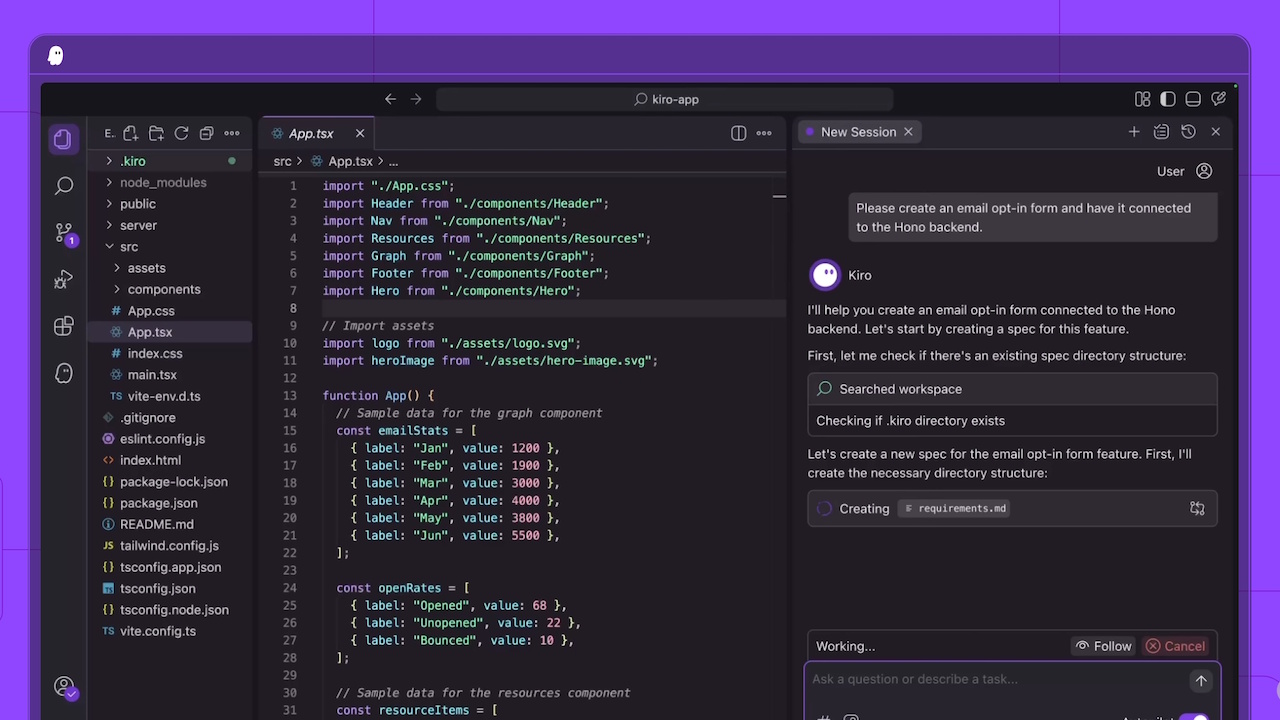Amazon Web Services (AWS) has launched Kiro, a new AI coding tool designed to tame the chaos of vibe coding, where AI often rapidly generates undocumented, unmaintainable code. Released in preview on July 14, Kiro uses autonomous agents to automatically create project plans and technical documents as developers write code.
This aims to solve a key problem: AI-generated software often lacks the formal structure needed for long-term support. By enforcing discipline, Kiro aims to turn rapid prototypes into reliable, production-ready systems.
The move heats up the AI coding race, pitting Amazon directly against rivals like Microsoft and Google. Amazon CEO Andy Jassy endorsed the tool on X, stating “Kiro has a chance to transform how developers build software.”The launch signals a strategic push beyond simple code completion into autonomous software development.

From ‘Vibe Coding’ to Viable Code
The term “vibe coding”describes the increasingly popular method of using AI to generate software from intuitive, natural language prompts. Si bien es rápido, este enfoque a menudo crea una pesadilla de mantenimiento. The official Kiro website frames its mission as moving from “vibe coding to viable code.”
As AWS explains on Kiro’s FAQ page, “when implementing a task with vibe coding, it’s difficult to keep track of all the decisions that were made along the way, and document them for your team.”Kiro se enfrenta directamente a esto actuando como gerente de proyecto. It breaks down prompts into structured requirements, design documents, and task lists before any code is written.
This specification-driven approach is Kiro’s core differentiator. In a blog post, product leads Nikhil Swaminathan and Deepak Singh said the vision is “to solve the fundamental challenges that make building software products so difficult — from ensuring design alignment across teams and resolving conflicting requirements, to eliminating tech debt…”The tool automatically updates these documents as the code evolves, ensuring plans and reality stay aligned.
Kiro is being launched with its own branding and domain, a departure from typical AWS service launches. It is free during the preview, with future paid tiers planned at $19 and $39 per month, according to its pricing page.
Introducing Kiro, an all-new agentic IDE that has a chance to transform how developers build software.
Let me highlight three key innovations that make Kiro special:
1 – Kiro introduces spec-driven development, helping developers express their intent clearly through natural… pic.twitter.com/ECT4F179aN
— Andy Jassy (@ajassy) July 14, 2025
A Specification-Driven Agent in a Crowded Field
Kiro entra en un mercado ferozmente competitivo, pero provoca un nicho único. No es solo otro asistente de finalización de código como el desarrollador de Amazon Q de Amazon. Instead, it is a full-fledged integrated development environment (IDE) focused on project structure, reflecting a big shift in AWS developer strategy.
This specification-driven approach contrasts sharply with the strategies of its main rivals. Microsoft está evolucionando el copiloto de GitHub a un agente más poderoso, recientemente abierta su extensión de chat para construir confianza comunitaria. Google, meanwhile, is pursuing a two-pronged attack with its comprehensive Firebase Studio and a free Gemini CLI for power users.
The competitive pressure is not just from incumbents. Las startups ágiles están buscando distintos nichos para abordar las necesidades empresariales específicas. French startup Mistral AI, for example, now targets large companies with its customizable, on-premise Mistral Code assistant, focusing on data privacy and control.
Anysphere, maker of the popular Cursor editor, is pursuing a “multi-surface”strategy to make its agents accessible from anywhere, as seen with its new web app. The tool’s influence is significant, as Amazon itself has reportedly been exploring its formal adoption internally.
However, the startup path is fraught with challenges that can alienate users. Anysphere recently faced significant backlash over confusing pricing changes. Its CEO, Michael Truell, issued a public apology, stating, “we recognize that we didn’t handle this pricing rollout well and we’re sorry. Our communication was not clear enough and came as a surprise to many of you.”
This market volatility underscores Amazon’s strategy with Kiro. By focusing on the core enterprise needs for rigor, documentation, and maintainability, Amazon is betting that providing a stable and predictable environment is the key to winning over large development teams in the long run.
The Autonomous Agent Arms Race Heats Up
Kiro’s launch is the latest salvo in an escalating “arms race”to build truly autonomous AI agents. The industry is rapidly moving beyond AI assistants that suggest code to agents that can complete complex, multi-step tasks independently.
This shift is most evident in the enterprise. El banco de inversiones Goldman Sachs confirmó recientemente que está pilotando al agente de IA de Cognición, Devin. The bank’s tech chief, Marco Argenti, described a future of human-AI collaboration, saying, “it’s really about people and AIs working side by side. Engineers are going to be expected to have the ability to really describe problems in a coherent way…”
The battle for AI talent and technology has become ruthless. La reciente saga que rodea la startup de codificación Windsurf ilustra las altas apuestas. After OpenAI’s $3 billion acquisition bid collapsed, Google poached its CEO and top talent.
This left Windsurf vulnerable, allowing rival Cognition to acquire the remaining company. The chaotic transition led Windsurf’s interim CEO, Jeff Wang, to post on LinkedIn that “the last 72 hours have been the wildest rollercoaster ride of my career.”
With Kiro, Amazon is making a powerful statement. It is not just participating in the AI coding trend but aiming to define its next phase, where structured, documented, and maintainable software is created through a partnership between human developers and autonomous agents.

